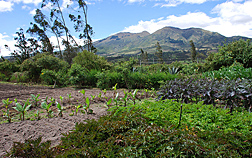The honeybee is not native to North America. Europeans had been keeping bees for centuries before bringing them to the new world. The first colonies of bees were brought over by the colonists for honey production and pollination. Beekeeping became more important to agriculture to boost crop yields. Farms initially had diversity in the crops that they produced. Farmers were raising their own food and a surplus to sell at market. Bees were kept at the farm and had a diversity of flowers and blossoms to forage.
As agriculture became more specialized and more reliant on economies of scale to production costs low, bees were moved around the country to pollinate one crop after another as they bloomed. This is done on a large scale with bees only having one type of blossom to forage for weeks at a time. Until the last hundred years bees were never used like this, transported on semi-trucks to one field or orchard after another. It boosts crop yields but bees never evolved to be dependent upon a monoculture, they aren't designed for the industrial agricultural paradigm.
We shouldn't be surprised of the large bee losses lately inclusively known as CCD or colony collapse disorder. Beekeepers that don't follow the blooming of crops around the country aren't having the same problems. Comparatively the losses of small natural and organic beekeepers are minimal. As an analogy imagine that you are a traveling salesman going to a new city each month but the catch is that you can only eat one type of food breakfast, lunch and dinner. Bacon one month, pepperoni pizza the next, plain rice the next and dry salads the next. After a season like this you would probably be malnourished, even though if you mixed it all you would be fine. Same things with the bees monoculture and traveling are making their immune systems diminished and more susceptible to disease.
Honeybees have done well for centuries on farms with diversity and farms set within a natural environment of diversity. As honey bees and some native pollinators like bats and wild bees continue to die off, industrial agriculture will have to change or be forced to change. Crop yields will continue to suffer until a more integrated approach is made towards pollinators.
Some alternatives are:
Set aside an easement on a farm for native and commercial pollinators to forage. This allows more diversity in pollinators for better pollination. Some pollinators do better in cool or wet weather than honeybees allow even better crop yield. More forage for bees will allow pollinators to be kept in the same area year round.
Vary the crops being grown, much like crop rotation diversity of crops will cut down on one single pest that thrives in an environment of their favorite plant to vex. Bees can fly up to 3 miles to forage so large farms can grow several tracts of crops giving some diversity to pollinators.
Research. More research needs to be done in finding better farming techniques that look at farming as a series of systems that all work together to be more self-sufficient. Growing crops to help fertilize others, growing crops to help pollinate others and growing crops to help conserve water in the field.
The problem with this type of research can be summed up in one phrase "follow the money". There will never be the economic incentive to do in-depth research into dynamic farming as producing the next block buster billion dollar GMO crop or pesticide. The financial incentive is just not their in research and more and more funding at the university level is coming from the big chemical and modified crop companies. Companies help fund research that they can use while other funding gets cut due to budget constraints.
Eventually a few enterprising individuals will show success and profit with a fully integrated permaculture method of farming. This will be about the same time oil becomes so expensive that conventional agriculture will be looking to alternatives to petroleum based fertilizers and long distances transport.




No comments:
Post a Comment